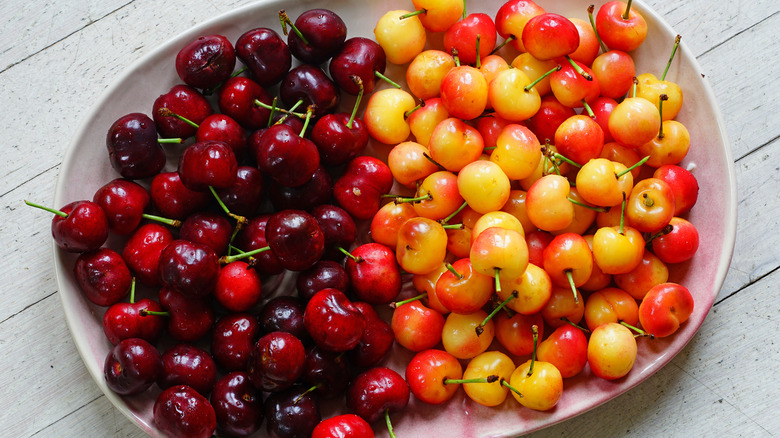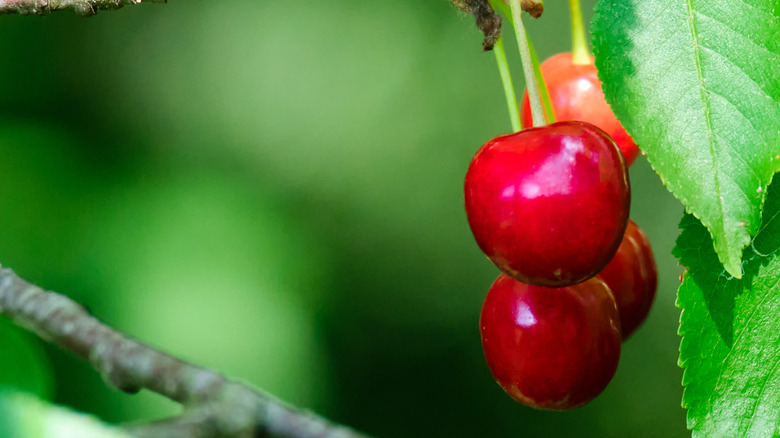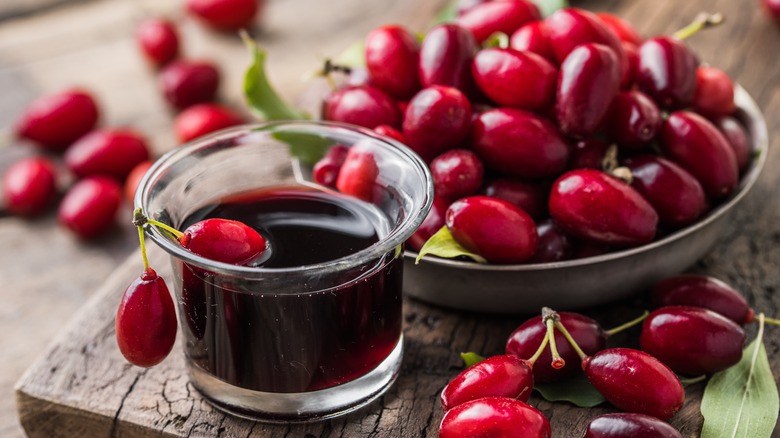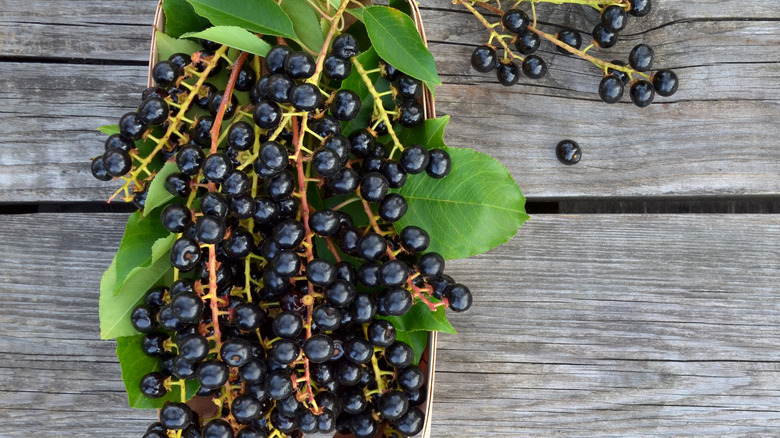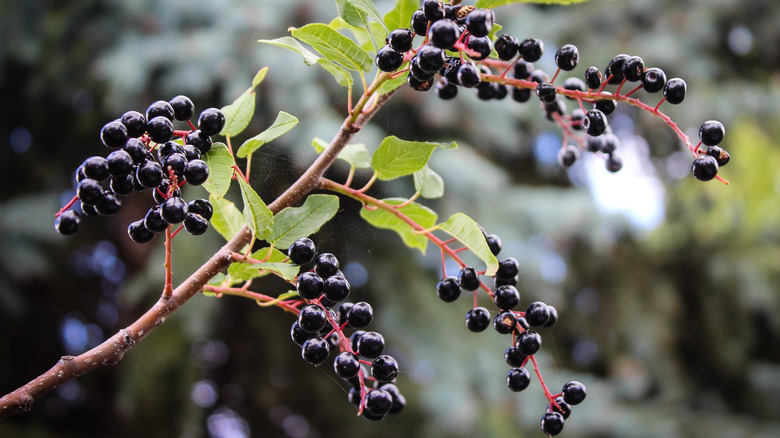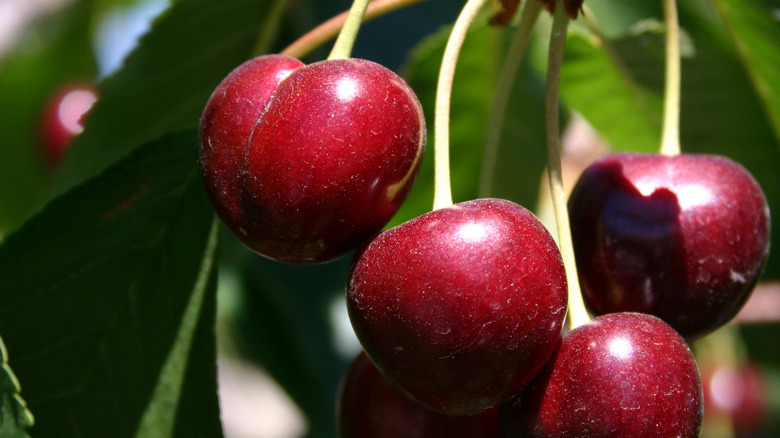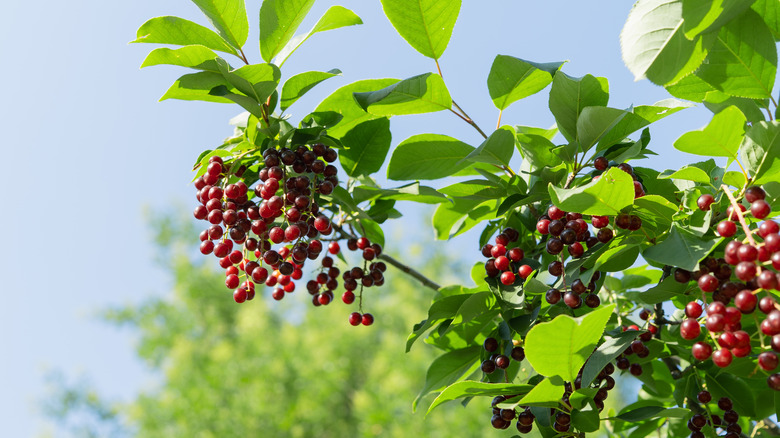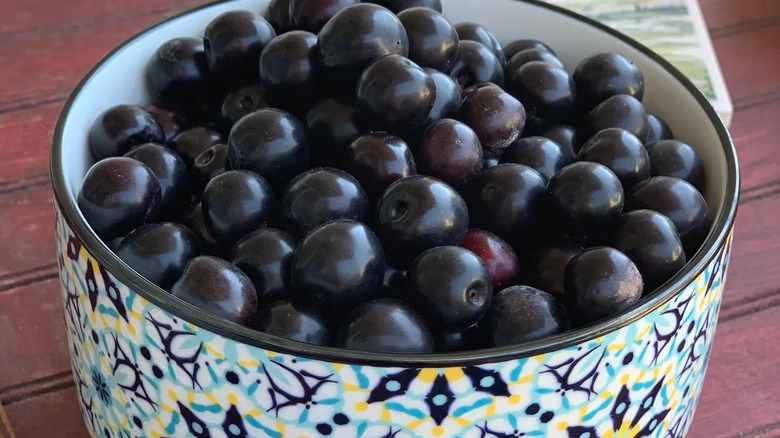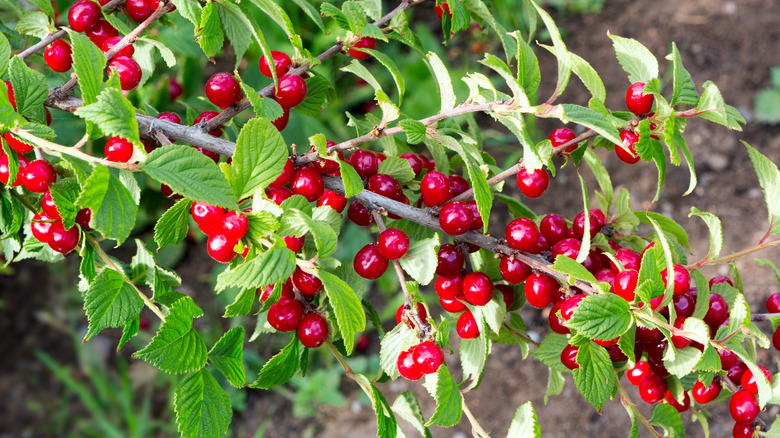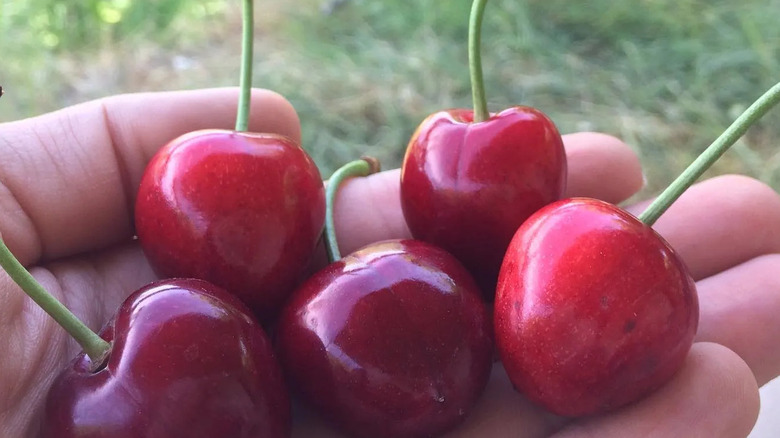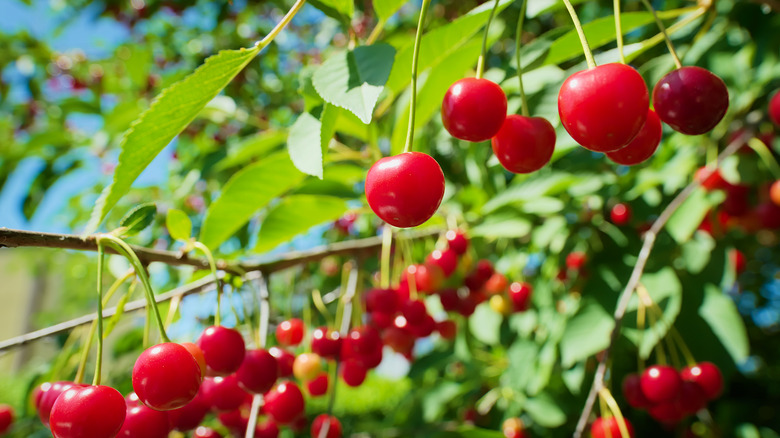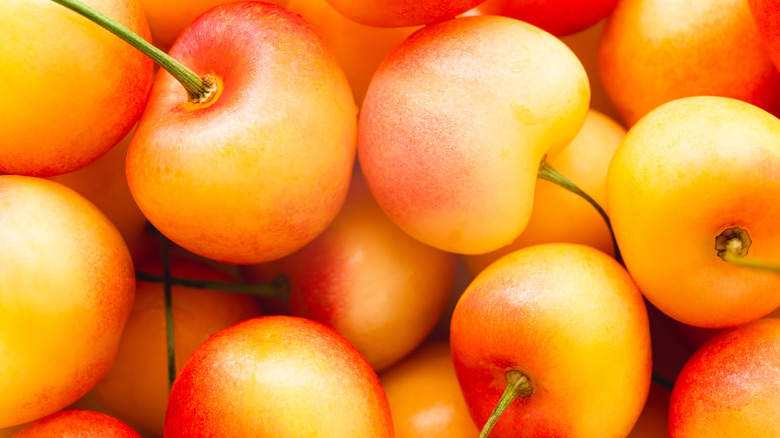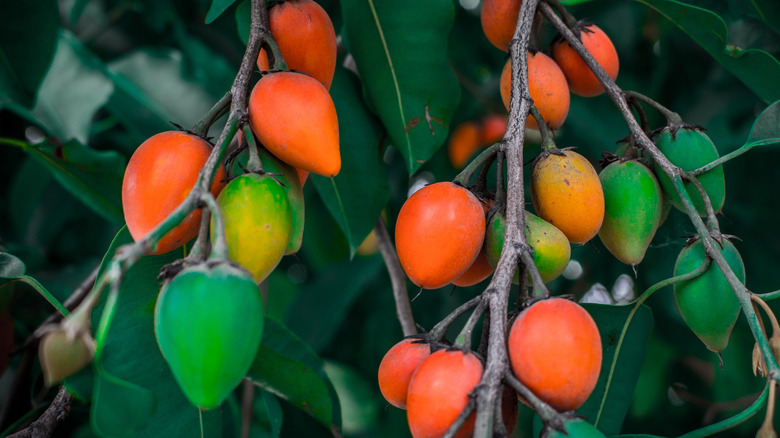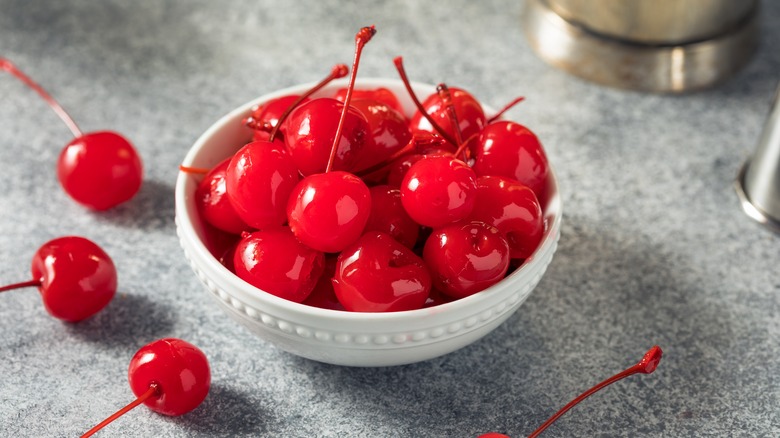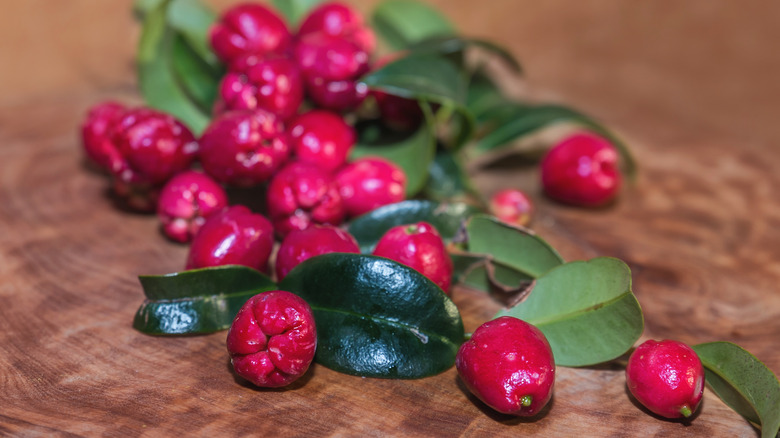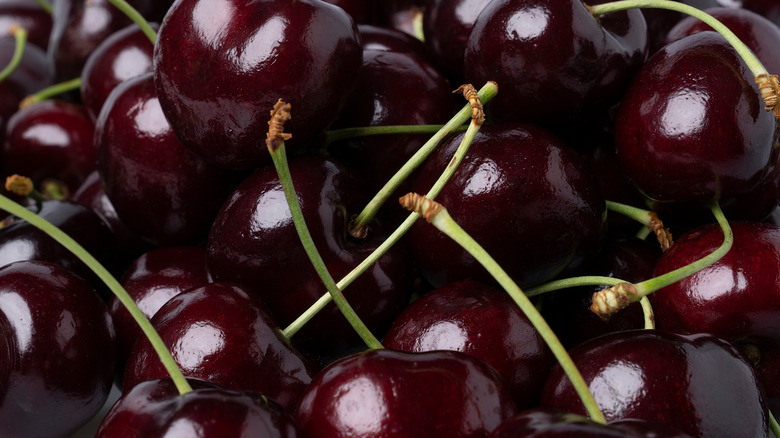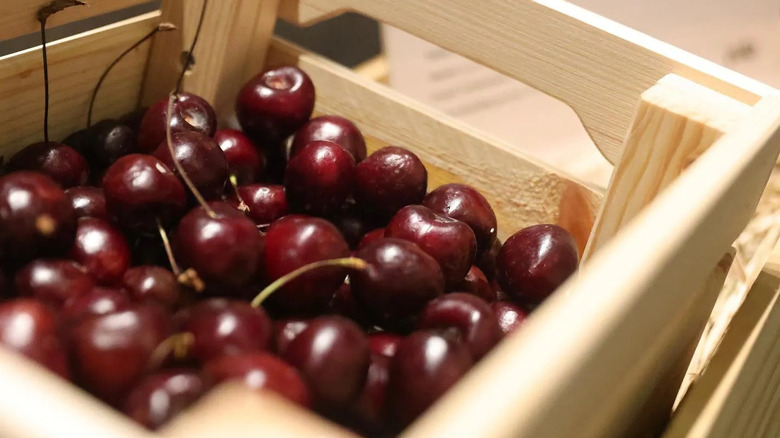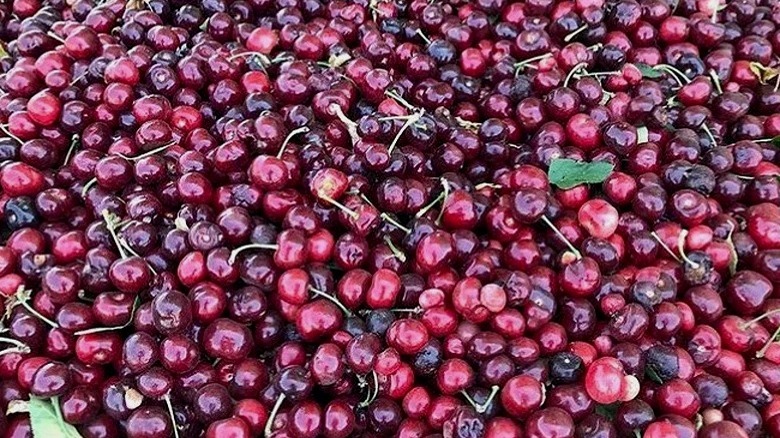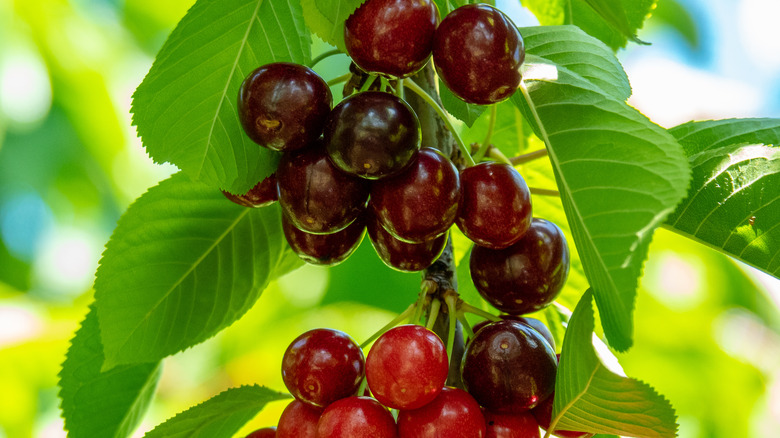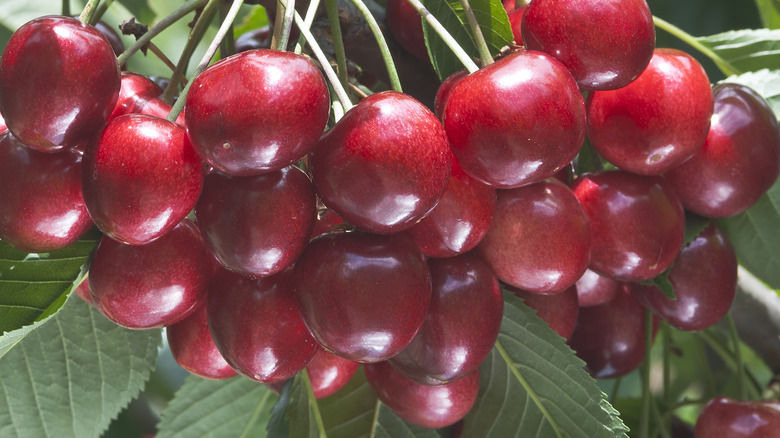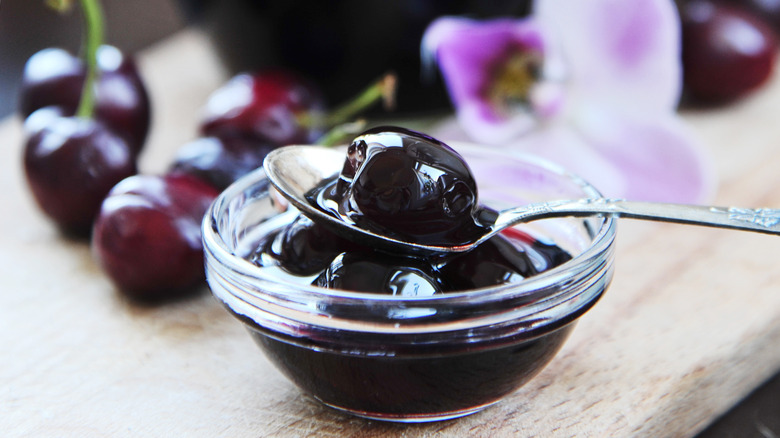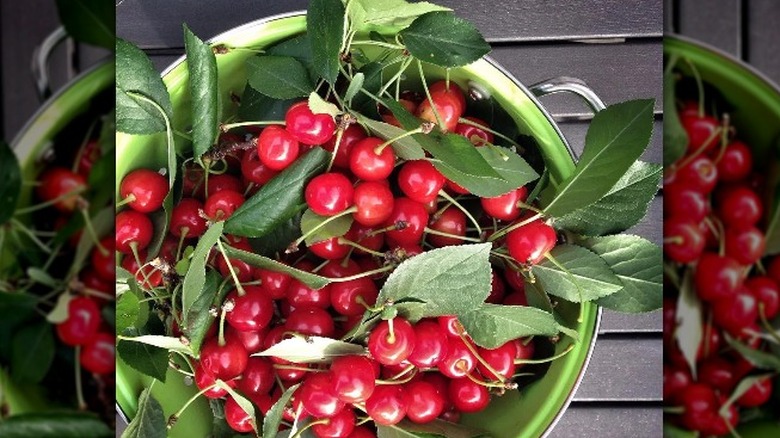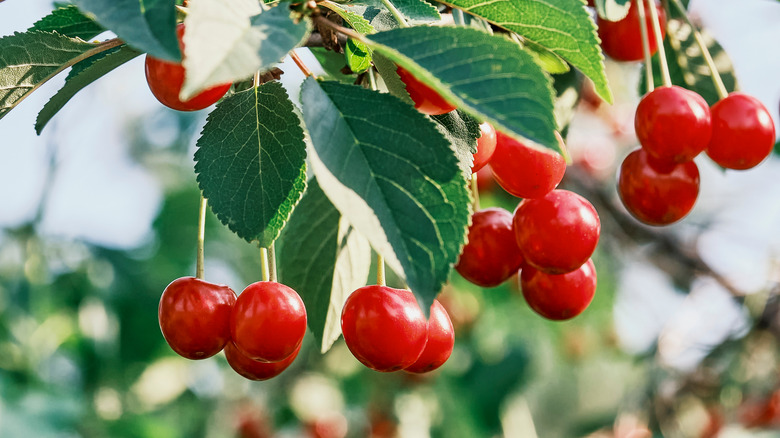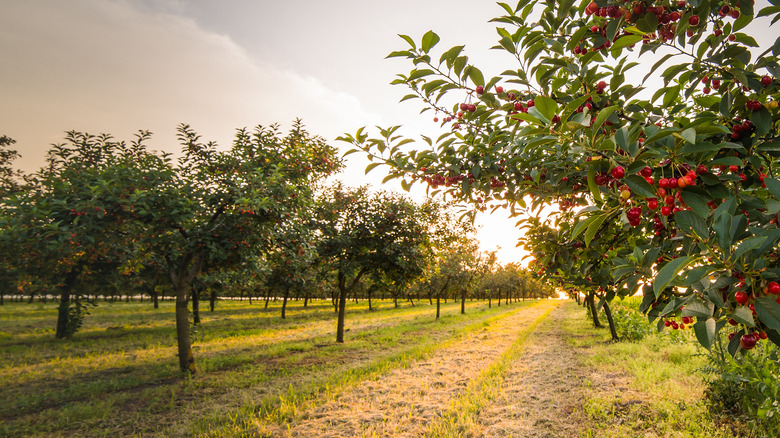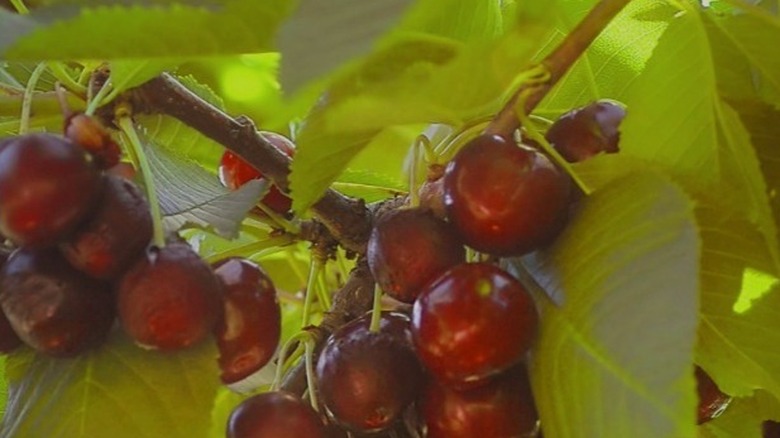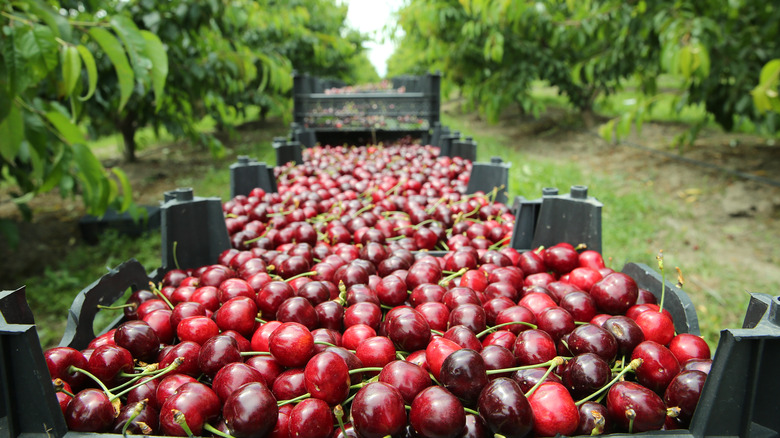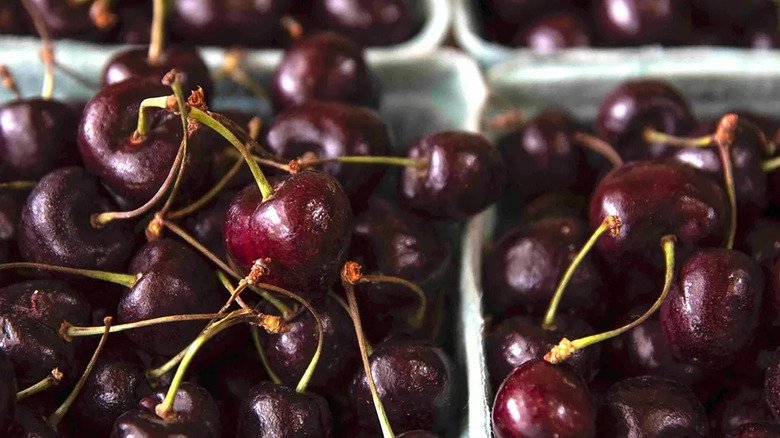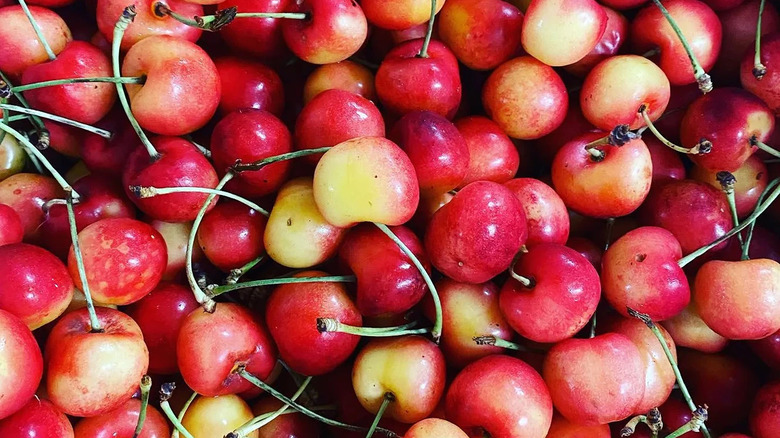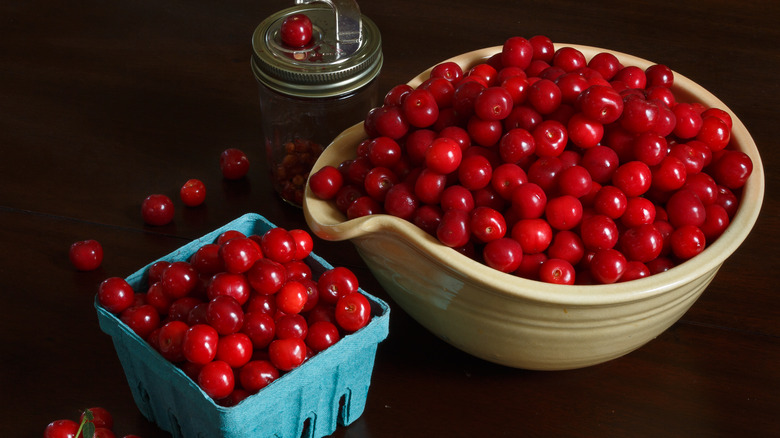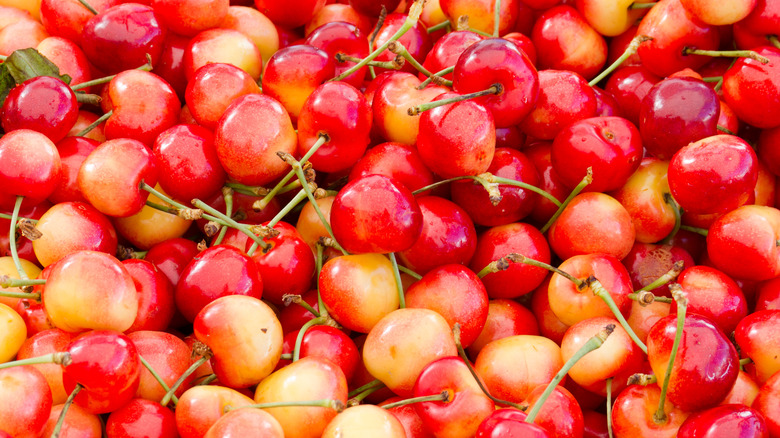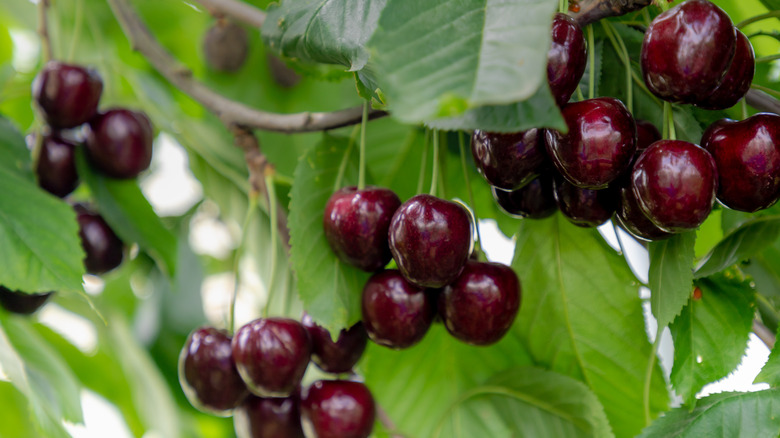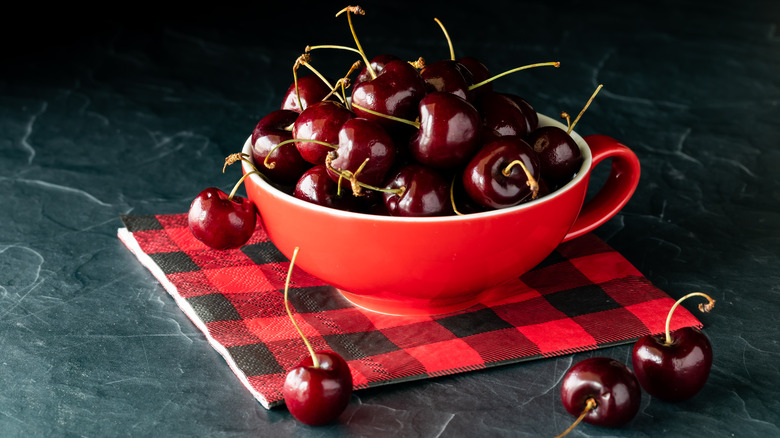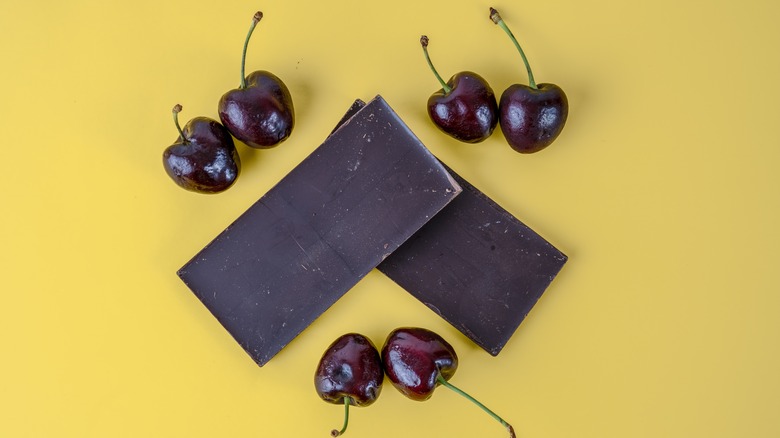32 Types Of Cherries Explained
Is there anything better than enjoying a fresh cherry pie in the summertime? Cherries are a popular stone fruit that people commonly use for culinary purposes. In general, cherries come either sweet or tart. The tart cherries are fantastic for making decadent treats like cherry ice cream, tarts, scones, and clafoutis. Additionally, tart cherries are excellent for making jam products and sauces. Sweet cherries are better for eating fresh because they aren't as puckery.
Appearance-wise, the fruit is usually red. However, depending on the variety, it can be other colors such as yellow, orange, purple, or black. Some may not realize that over 1,000 kinds of cherries exist, some being wild, and some are commercially cultivated (via Montana Harvest of the month program). You might wonder what characteristics are acknowledged when distinguishing different kinds of cherries from others. Many varieties have unique features, but these 30 specific types are especially remarkable in their own ways.
1. North Star cherry
With its deep red hue and slightly tart flavor, the North Star cherry is an impeccable fruit. Interestingly enough, this type of cherry was only introduced 72 years ago (via Johnson's Nursery Inc.). The cherry is ideal for gardeners and bakers alike. Home gardeners find the North Star cherry tree impressive because it can produce around seven gallons of fruit yearly. The fruit is a dwarf cherry, and the tree usually doesn't grow higher than about 10 feet, which makes picking the fruit relatively easy. As for the cherry's uses in the culinary world, the North Star is a prime cherry for bakers to use in pies and other desserts.
2. Cornelian cherry
The Cornelian cherry is a type of fruit cultivated in several countries and specific regions in the United States. According to Cricket Hill Garden, this type of cherry is notable for its high vitamin C content. Since the Cornelian cherry is large, it's perfect for juicing. The cherry juice can be enjoyed as is or used to make wines and pickled foods, depending on how mature the fruit is when it's juiced. Compared to other kinds of cherries, the appearance of the Cornelian is somewhat peculiar. Rather than being heart-shaped or round, the fruit is more of a long oval-like shape. When the cherry fully ripens, it's a beautiful crimson red.
3. Black cherry
The black cherry is a fruit that changes from a deep red color to a jet-black fruit in the early fall. You can enjoy this fruit as is or cook it into foods like cobblers or jams. What makes the black cherry tree unique is that aside from the fruit's value, other parts of the tree have value too. Both the bark and leaves hold a noticeable cherry scent. As reported by Lady Bird Johnson Wildflower Center, people commonly utilize the bark by making a specific medicine that treats coughs and colds. If you were to plant the black cherry tree, it would provide you with delicious fruit and gorgeous white flowers that appear in the spring.
4. Chokecherry
Living up to its name, this cherry can be surprisingly sour if it hasn't fully ripened. The fruit is also called the bitter-berry or the Virginia bird cherry (via My Garden Life). Once this cherry has matured, it is not red like other cherries but rather a dark purple color. This type of fruit grows in the wild and is an essential food for wildlife. According to Lady Bird Johnson Wildflower Center, certain parts of the shrub were used medicinally by native settlers. The tea made from the chokecherry plant can fight minor cold and cough symptoms, as well as more serious conditions like tuberculosis.
5. Bing cherry
Bing cherries are one of the most well-known types of cultivated cherries. Although they're commonly grown for commercial use, it's also popular with home gardeners. When looking at types of cherries and what makes them unique, this cherry stands out for its potential health benefits and many uses. The fruit contains antioxidants and vitamins, such as A and C. Who doesn't love snacking on something that could potentially improve the immune system? Aside from its nutritional value, the bing cherry has a pleasant appearance and taste, making it ideal for eating raw or cooking. These sweet cherries certainly make their mark in the world of fruit.
6. Pin cherry
Pin cherries are not typically commercially grown; they usually grow in the wild and must be foraged. The shrub naturally appears in certain regions of Canada and the United States (via USDA). However, if you're lucky enough to get your hands on some, the fruit is excellent for creating jams and jellies because of its slightly tart flavor. This type of cherry is markedly tiny, with the average pin cherry's diameter being less than half an inch across. The fruit is a vibrant red color that is hard not to appreciate. It is no wonder that the pin cherry attracts many kinds of wildlife, for example, moose, deer, and birds.
7. Sand cherry
This type of wild cherry is fantastic because you can enjoy it raw without special preparation. Also, the fruit ripens mid-summer, making it perfect for creating summer desserts like cherry ice cream. Of course, many people use it to make fruit jams. If you wanted to preserve the fruit for later use, you could also dry it. Sand cherries have slightly different characteristics depending on where they grow, so they've been broken down into three varieties. The USDA acknowledges the three varieties as Western sand cherry, Eastern sand cherry, and Great Lakes sand cherry. Unfortunately, some states list the sand cherry as an endangered or threatened plant.
8. Nanking cherry
This type of cherry grows on a shrub native to Asia, but it has become popular in the United States because of its charming foliage and flavorful cherries. The fruit's taste is slightly puckery, best used for cooking and baking. Creating a homemade cherry tart with this type of cherry will undoubtedly give you a decadent dessert. Although, you can enjoy it raw as well if you don't mind a bit of tang. According to Arbor Day Foundation, the plant grows best in the central and northern plains of the United States because of the region's climate. If you plant a Nanking cherry tree, you can expect to see bright red fruit ripen every summer.
9. Turkish sweet cherry
The Turkish sweet cherry is known for its sugary flavor and succulent texture, which makes the cherry understandably loved. This type of cherry is also called the 0900 Ziraat variety. The fruit is native to Turkey, which produces more cherries than any other country in the world. The Turkish sweet cherry is large compared to other cherries. Rather than being a radiant red color, the cherries are a deeper shade of red once they're fully mature. It is not uncommon to juice Turkish sweet cherries because their flavor and size make them the perfect candidate for doing so, as reported by Fresh Fruit Turkey.
10. Early Richmond cherry
The early Richmond cherry is one of the many tart cherries that thrive in states like Illinois and Kansas. But, do you know the real reason why so many cherries are grown in the Midwest? It's because the climate there is like heaven for a tart cherry tree that needs cold winters and average summer temperatures in order to flourish. Per Arbor Day Foundation, one unique property of the early Richmond cherry tree is that its fruit is ready to be harvested seven days earlier than other types of cherries. In addition, the cherries are plump and have a pleasant but strong cherry taste.
11. Rainier cherry
Have you ever had a yellow cherry? Although most cherries are red, this type of cherry only has traces of red, with the majority of the fruit being yellow. With its fascinating golden appearance, the Rainier cherry is perfect for garnishing desserts and beverages. In addition to its distinct look, the fruit's flavor is exceptionally delightful. You can credit the bing cherry and van cherry for the Rainier cherry's high-quality taste because the Rainier is a hybrid of the two. (via Specialty Produce). You can harvest this fruit between the spring and summer months, earlier than other types of cherries, such as the sand cherry, which you can pick around July.
12. Spanish cherry
This cherry tree is noteworthy because people can use it for medicinal and culinary purposes. The fruit is light red, almost orange, and has a mild flavor that's not overly bitter or sweet. Unlike other cherries, the Spanish cherry is egg-shaped and tastes somewhat similar to fellow stone fruit, the apricot, as reported by Ourique Farms. Historically, people have taken advantage of the fruit's medicinal properties to treat conditions such as fevers, wounds, eczema, and more (via The Plant Attraction). In addition, the seeds and bark from the tree have other unique uses; frequently, people turn them into perfumes, colorants, and even jewelry.
13. Maraschino cherry
What would a hot fudge sundae be without a shiny and vivid maraschino cherry placed on top? Some may not realize that companies preserve, sweeten, and color the cherries because chefs typically use them for garnish in the culinary world. Unfortunately, the fruit isn't naturally that intense in color, but it doesn't mean you shouldn't appreciate it. In fact, the boozy origin of maraschino cherries is quite interesting. The alluring candied cherries first came about because of Dominican monks who soaked the cherries in alcohol. Word of the delicious cherries got around, and eventually, the cherries made their way to the United States. From there, Oregonian professor Ernest Wiegand created the preservation process that companies still use today.
14. Magenta cherry
Imagine taking a bite of a juicy cherry, but the flavor of a Granny Smith apple meets you instead. That scenario is exactly what would happen if you were to try a magenta cherry. According to PictureThis, just like a sour apple, the tartness of the fruit doesn't stop people from eating it uncooked. Although, it does make for great jam and baked goods as well. This fruit is also distinctive because of its blush-red appearance, firm skin, and succulent flesh. Magenta cherries, also known as brush cherries, are native to Australia but can flourish in many tropical climates.
15. Kordia cherry
By the time it's August, most cherries have already matured, and people have picked them, but the Kordia cherry is just starting to ripen. Although its harvesting period is a bit later in the summer than most, this fruit is certainly worth the wait (via Thompson & Morgan). Kordia cherries have a pleasantly sugary taste. They are plump and substantial in size; they're almost jet-black at their peak. Sweet cherries like this are ideal for both mid-day snacking and cherry pie making, which makes planting the tree appealing to home gardeners. Aside from the benefits of the fruit, the tree itself is a charming and attractive-looking addition to any garden.
16. Tieton cherry
The Northwest region of the United States can take credit for growing a large amount of this cherry type, the Tieton. The name of this cherry actually came about from the Tieton River in Washington State, near the region where the cherries originated. It is not a wild fruit; instead, the Tieton cherry is a hybrid created from two different cherries. Tieton cherries have a mild but pleasant flavor, which gives creative freedom to people who want to use them for cooking and baking. Specialty Produce explains how the fruit pairs well with sweet and savory ingredients, making the Tieton an extremely versatile fruit.
17. Tulare cherry
Tulare cherries are ideal for being commercially grown because they do well under storage and transportation. In fact, the Tulare cherry is one of the essential trees grown in Central California, where the cherry industry is highly successful. The fruit is also known for having potential health benefits as well. Per Specialty Produce, Tulare cherries have abundant amounts of vitamins A and C, which can help create a healthier immune system and decrease inflammatory issues. Aside from its economic and health advantages, the fruit is flavorful and has a satisfying texture. It sometimes has a marbled appearance, exhibiting light and dark red shades.
18. Sweetheart cherry
Similar to the Kordia cherry, the sweetheart cherry has a somewhat late harvesting season compared to other types of cherries. The unique thing about the sweetheart cherry is that the harvesting period draws out longer than usual, meaning you have more time to pick and enjoy them, according to GardenFocused. The sweetheart cherry hasn't been around long — the Summerland Research Station introduced it just over 30 years ago. People generally savor the fruit in its raw form because of its enjoyable taste. When biting into a sweetheart cherry, you will be overwhelmed with sweetness and later experience a slightly tart aftertaste.
19. Santina cherry
This dark red cherry is ideal for baking and cooking, but you can enjoy it uncooked as well; it is flavorful without being too extreme or overwhelming. The Santina cherry is ideal for cheese and charcuterie boards because its taste complements many types of meat and cheeses (via Gardening Know How). Whether you like utilizing your cherries right after harvesting or preserving them for later use, this fruit is the perfect option. This tree thrives best in the central and eastern regions of the United States and is considered valuable. A Santina cherry tree will undoubtedly elevate the appearance of any lawn while producing exquisite drupes.
20. Amarena cherry
The Amarena cherry is an Italian variety of cherry that is small in size but has impeccable flavor, making it stand out from other types. Like maraschino cherries, they're commonly soaked in syrup and sold in jars or cans. You can find pitted Amarena cherries at grocery chains because people commonly use them in desserts. Although this type of fruit grown in Italy has massive commercial value, you can also buy the cherry tree to plant in your garden. Per One Green World, the tree can grow up to 15 feet tall and produce roughly 50 pounds of stone fruit.
21. Meteor cherry
Some cherries are not ideal for cooking and baking because they lose structure and become a mushy mess when put under high heat. However, this is not the case for the Meteor cherry (via Minneopa Farms). This fruit is an excellent candidate for scones, cobblers, clafoutis, and more because of its meaty flesh. On the other hand, this drupe is also suitable for juicing because of its considerable size. The appearance of the meteor cherry is unique because it has a red outer skin, but the inside is a beautiful golden color. From its luscious inner texture to its vibrant exterior, this fruit is worth noting.
22. Evans cherry
Native to Canada, this cherry has a bright appearance and a slightly tangy taste. In some cases, people call the Evans cherry by another name; the Bali cherry. Its harvesting season slightly differs depending on the region it's being grown. The Evans cherry is appealing to gardeners because the tree produces an exceptionally high amount of fruit, which they can sell along with being a terrific option for a cherry tart and a lovely jam. Also, wildlife enjoys eating this fruit, as reported by Johnson's Nursery, so if the tree doesn't have any protection, animals like raccoons or birds can get ahold of it.
23. Cowiche cherry
This type of cherry was trademarked in 2007, resulting from a cherry breeding program in Washington state. This stone fruit has a strong flavor and is large in size; its color ranges from bright red to maroon to purple. Interestingly, the Cowiche cherry isn't the only drupe the program focuses on. Washington State University has a project that tests and improves the characteristics of sweet cherries grown in the Northwest, as reported by the American Society for Horticultural Science. Unfortunately, when comparing the harvesting season to the bing cherry, the Cowiche isn't ready to be picked up until a week afterward.
24. Lambert cherry
This cherry is one of the most in-demand commercially grown and sold cherries because the Lambert cherry tree produces a large volume of fruit yearly, per Minneopa Orchards. Whether the tree is planted for commercial use or is a lovely decorative addition to your garden, the fruit it bears has plenty of value. The Lambert cherry has a satisfying snap-like bite, and its skin brings a nice contrast in texture compared to its juicy interior. The Lambert cherry is sweet rather than sour, making it a refreshing snack or a nice ingredient for a salad.
25. Lapins cherry
Here is another sweet cherry type; the Lapins cherry originally emerged from Canada, as stated by Stark Bro's. This cherry tree is appealing to gardeners because it is self-pollinating, which is uncommon for a sweet cherry variety (usually, only tart varieties can do so). This stone fruit is plump and has a dark yet bold-red appearance. You can pick these glossy fruits from the tree once they fully mature in July. From there, eat them like candy or turn them into desserts, syrups, or jams. There is no limit to the Lapins cherry because its flavor, consistency, and look are superb.
26. Van cherry
These cherries can be harvested mid-summer, and their sweet flavor pairs well with savory foods, including pork and poultry (via Gardening Know How). Not every type of cherry can complement the flavors of savory foods, but the Van cherry does an excellent job at it. Make a cherry sauce to serve over pork chops, and you won't be disappointed. People can also use this fruit to make confections for which cherries are best known. The Van cherry's exterior color is so deep that it reminds you of red wine. If you can get ahold of some Van cherries, they might become your new favorite fruit.
27. Early Robin cherry
Often confused for the Rainier cherry because of their similar qualities, the Early Robin cherry has slight differences, one of which is that it ripens up to two weeks earlier than the Rainier. Another key distinction between the two varieties is that they have different pits. The cherry's flavor is sweet yet light, which is enjoyable because the taste isn't overwhelming. One thing that makes the Early Robin cherry unique is that it was discovered in the early '90s by a man named Robin Doty, who later patented the fruit in 2003, per Good Fruit Grower. Although the Early Robin is a newcomer by cherry standards, it has dramatically impacted the cherry world in the Northwest.
28. Montmorency cherry
Here is the most popular sour cherry grown in the United States, which Americans appreciate for a good reason. You can generally harvest the Montmorency cherry in late June. It is plump fruit with a scarlet red exterior, precisely what you imagine a perfect cherry to be. Once you bite into it, you'll be greeted by a delightfully tangy, slightly bitter, golden pulp that is a splendid contender for baked goods. Unfortunately, wildlife enjoys eating this cherry, so home gardeners should take precautions to keep the fruit safe, such as protecting the tree with some type of netting (via Arbor Day Foundation).
29. Queen Anne cherry
The Queen Anne cherry has a unique appearance, and the skin has a natural marbled look with shades of golden yellow, light orange, and red. Aside from its charming looks, people typically enjoy this cherry uncooked. Because of its naturally sugary taste, you can enjoy this fruit immediately after picking it, and no special preparation is needed. However, it is also great for canning and other uses. As stated by Minneopa Orchards, you can make famous maraschino cherries from this naturally sweet variety. This type of stone fruit is dreamy for gardeners and home cooks because of its high-quality attributes.
30. Regina cherry
This type of cherry originated in Germany but can be grown in some regions of the United States, specifically in the central and eastern areas. As reported by Gardening Know How, the delicious fruit is typically harvested in early summer and has the perfect balance of tasting like nature's candy while also having hints of bitterness. The skin is a rich burgundy color with a natural glossy look. One positive benefit of the Regina cherry is its excellent storage capabilities; the fruit will last a month after being picked. Of course, you can always freeze, dry, or can the cherries to extend their shelf life.
31. Chelan cherry
The Chelan cherry was bred for an early ripeness compared to the popular Bing cherry. Although the Chelan is ready a little earlier, it packs the same sweet, floral flavor and beautiful red hue, making it hard to distinguish between them. Its sweetness is also comparable to a Bing with between 16% and 18% sugar. The deep-red, medium-sized fruits are perfect for snacking or baking into a pie.
Chelan cherries were selectively bred through agricultural trials at Washington State University, and are relatively new on the cherry scene. But if you look carefully at the bags of cherries in your local grocery store, you may be able to find this delectably sweet variety.
32. English Morello cherry
English Morello cherries are plump, heart-shaped fruits that ripen toward the end of cherry season. The sour cherry's flesh is very tart and aromatic and produces a vibrant wine-red juice. These qualities, along with the superior flavor of the fruit, have led to it being used for baking and cooking for centuries. The flesh of the fruit is also relatively stable and firm, so it will hold its shape for many different culinary applications. In addition, the fruit's sour flavor makes it a staple for jams, syrups, and juices. Many individuals will also plant this tree because it is adaptable to several different growing regions and blooms beautifully for a long while.
